mineral requirements of high producing sows
Pressures on mineral reserves: what’s the best way to meet the needs of highly prolific sows?
The mineral requirements of high producing sows are largely unknown. The research to date demonstrates that both macro- and microminerals become depleted in sows with advancing parity and that high productivity exacerbates depletion.
There apparently are periods during the reproductive cycle where both macro- and microminerals are needed in greater quantities. These periods generally occur during late gestation and lactation, but other times may also be critical. Simply fortifying the sow diet with higher dietary levels of macro- and microminerals may not be desirable as they may reduce reproductive performance.
The use of organic minerals has recently been shown to improve litter size over a six parity period. Although organic selenium (Se) has been shown to have these effects, other trace minerals are also probably involved in improved sow reproduction.
Trace mineral effect on sow reproductive performance
Our previous report indicated that when dietary levels of inorganic trace minerals were increased above the NRC (1998) requirement levels, there was a decline in litter size in the number of total and live pigs born, whereas there was an increased litter size when organic (Bioplex®, Alltech Inc.) minerals were fed (Figure 1). The decline in reproductive performance appeared to be exacerbated when the gestation diet also contained higher dietary levels of calcium (Ca) and phosphorus (P) than recommended by NRC (1998).
The dietary sources of trace minerals were either the organic Bioplex® minerals or inorganic mineral salts, generally in the sulfate form. When the Bioplex® study was compared to a previous sow reproductive study, which evaluated the organic selenium source Sel-Plex® (Alltech Inc.) vs. the inorganic selenium source sodium selenite, we can see from Figure 2 that both the Sel-Plex® and the Bioplex®-supplemented diets resulted in increased litter size.
It is interesting to note that the increase was approximately one additional pig per litter when the Bioplex® trace minerals fortified the diet, while the addition of Sel-Plex® as the only organic mineral increased litter size by approximately 0.3 pigs per litter. Although this comparison is statistically confounded, the results imply that litter size response to Bioplex® minerals (which included Sel-Plex®) was greater than response to Sel-Plex® alone.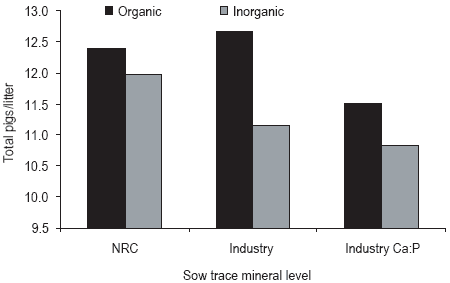
Figure 1. Effect of dietary trace mineral sources and levels on sow reproductive performance over 6 parities (n = 375 litters).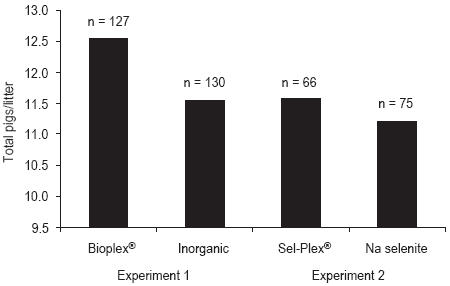
Figure 2. Comparison of trace mineral sources fed to the reproducing sow on litter size in two different experiments.
One additional comparison can be made between these studies. In the Sel-Plex® study of Mahan and Peters (2004) and the Bioplex® study of Peters and Mahan (in press), both gestation diets contained dietary calcium levels of 1.0%, somewhat higher than NRC (1998) recommendations, but considered similar to commercial sow gestation diets.
In the study of Peters and Mahan (in press), when the sow diet was supplemented with either Bioplex® or inorganic trace minerals, litter size was lower than when the diet contained NRC (1998) calcium and phosphorus levels (Figure 1). The comparison of these two sets of data again show that litter size was greater when the Bioplex®- or the Sel-Plex®-fortified diets were fed, but that overall litter size was generally similar between the two studies (Figure 3).
It should be noted that the management and facilities used in these two experiments were similar; thus, one would suspect that differences could be attributed to dietary minerals more so than to sow management. Feeding high calcium diets to gestating sows is relatively common in the industry as the depletion of minerals in sows is well recognized.
The depletion of all minerals is exacerbated with high sow productivity (Figure 4). It is possible that high dietary calcium levels can have potentially negative effects on other minerals in the digestive tract (Figure 5).
Sequestering of other macrominerals by calcium (e.g., P, S) is well recognized and can reduce their absorption and bioavailability as well as that of some trace minerals (e.g., Fe, Zn, Cu). During early gestation when the demands for calcium are not as great for fetal development as later or during lactation, dietary calcium and phosphorus levels should perhaps be modified. The mineral needs of the gestating and lactating sow should not be considered constant at each reproductive phase.
Figure 3. Comparison of sow dietary trace mineral sources on litter size in two different experiments when fed high calcium (1.0%) gestation diets.
Figure 4. Body mineral losses after a 3-parity period (compared to non-gravid control).
Figure 5. Principles of calcium and phosphorus absorption.
Fetal mineral needs
During fetal development, body tissues form at different rates and thus different nutrients are needed. As with certain vitamins, there may be ‘critical windows’ when there might be greater requirements for specific trace minerals to allow normal tissue developmental processes.
When pigs from 45 days postcoitum to birth were analyzed for total mineral content, the data showed that approximately 50% of the total minerals used in developing fetal tissue were deposited during the last 14 days of gestation (Figure 6). Thus, the demand for trace minerals from the diet of the sow, and subsequently demand for her mineral body reserves, play important roles in the normal development of fetal tissue, with much of this growth occurring during late gestation.
Figure 6. Total fetal mineral content from 45 days postcoitum to birth.
Both calcium and phosphorus requirements are greater during the last two weeks of gestation compared to earlier stages of development. Figure 7 demonstrates that a litter of 12 pigs requires approximately 73 and 44 g of Ca and P, respectively, during this 2-week period.
Although there is a linear increase in the need for both of these macrominerals during this period, fetal needs are the greatest immediately prior to birth. Consequently, the calcium and phosphorus demands from the sow can result in bone demineralization and the possible ‘breakdown’ of the sow skeleton during this phase of gestation.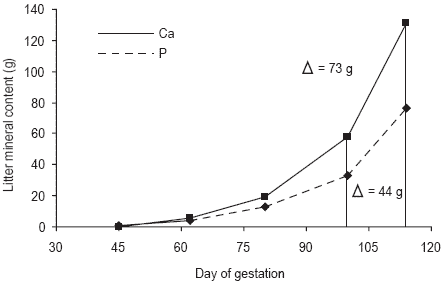
Figure 7. Total litter calcium and phosphorus contents of pig fetuses from 45 days postcoitum to birth.
The micromineral requirement of the developing fetus from 45 to 114 days of gestation is similar to that of the macrominerals, albeit at lower quantities. When iron (Figure 8) and zinc (Figure 9) depositions are plotted for the various days of gestation, each clearly shows that the greatest deposition occurs during the last two weeks of pregnancy. The same general trend also occurred with other trace minerals but is not presented here.
These results suggest that the trace mineral needs of the pregnant sow during the latter part of gestation are great, and when sows are developing larger litters, the demand on mineral needs is exacerbated compared with the development of smaller litters.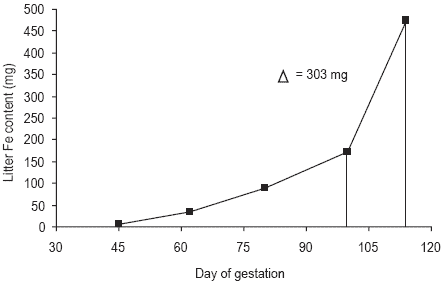
Figure 8. Total litter iron content of fetal pigs from 45 days postcoitum to birth.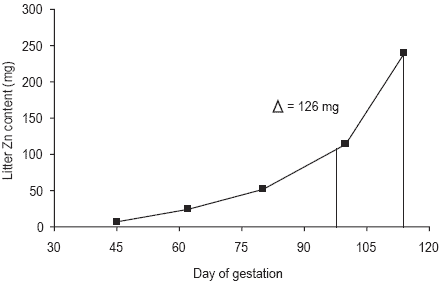
Figure 9. Total litter zinc content of fetal pigs from 45 days postcoitum to birth.
Nursing pig mineral needs
Although the last week of gestation has a high mineral requirement from the sow in order to meet fetal demands, it is during lactation that these mineral needs are exacerbated.
Figure 10 demonstrates that sows nursing 11 vs. 8 pigs per litter had a daily deposition of 85 vs. 68 g/day, respectively, for litter growth. When the macrominerals are individually expressed, the need for calcium is 19.0 vs. 13.3 g/day for the two litter sizes during the last 10 days of a 21-day lactation period (Figure 11). This need is greater when 11.7 vs. 4.7 g/day were deposited in the litters for the initial 11 days of lactation.
Consequently, mineral demand appears to increase with the stage of lactation or as sow milk production increases. When calcium or phosphorus needs are expressed on an individual pig basis, the calcium and phosphorus contents of the individual pigs for both litter sizes are similar (unpublished data).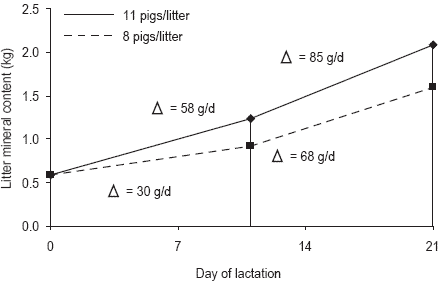
Figure 10. Total litter mineral content of nursing pigs at birth, 11, and 21 days of age for two litter sizes.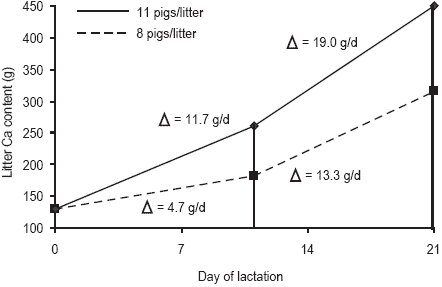
Figure 11. Total litter calcium content of nursing pigs at birth, 11, and 21 days of age for two litter sizes.
The trace mineral contents of the two litter sizes for the various trace minerals are presented in graphic form in Figures 12-16. The same general trend evident with the macrominerals is also present for total zinc (Figure 12), i.e., greater in the larger litter of pigs. However, the content in the litter when expressed on a daily basis does not appear to increase at the same rate as calcium.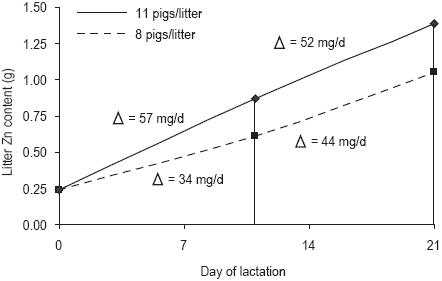
Figure 12. Total litter zinc content of nursing pigs at birth, 11, and 21 days of age for two litter sizes.
Although a litter of 11 pigs retained more total zinc during the initial 11 days of lactation, that level was greater than that retained during the latter 10 days of lactation. This difference is perhaps more evident with the iron and copper contents of pigs at the various stages of lactation. Both iron (Figure 13) and copper (Figure 14) had greater daily retention in the total litter during the initial 11 days of lactation than during the latter 10 days of a 21-day lactation period.
Although some of the iron in the pigs undoubtedly can be attributed to iron injections (200 mg) administered in the days immediately postpartum, such was not the case for copper. Figure 15 shows that the individual iron content of pigs appeared to plateau from 11 to 21 days of age and the iron content in the individual pigs was greater in pigs of the smaller litter size.
The same trend was also apparent in the copper content of pigs, where the copper content for both litter sizes on an individual pig basis was similar at 11 days, but was lower at 21 days in the larger litter sizes (Figure 16). These results suggest that sows of high productivity may be unable to meet the trace mineral needs of nursing pigs with the dietary levels provided and that larger litter size exacerbates the need for trace minerals.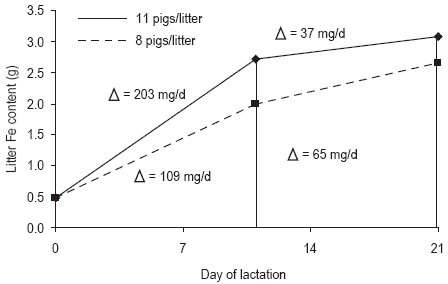
Figure 13. Total litter iron content of nursing pigs at birth, 11, and 21 days of age for two litter sizes.
Figure 14. Total litter copper content of nursing pigs at birth, 11, and 21 days of age for two litter sizes.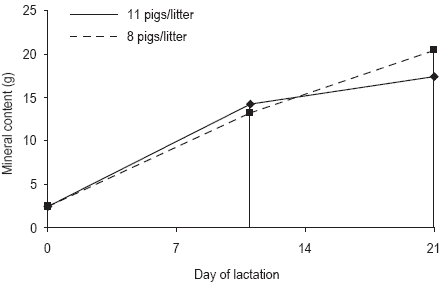
Figure 15. Iron content of individual pigs at birth, 11, and 21 days of age for two litter sizes.
Figure 16. Copper content of individual pigs at birth, 11, and 21 days of age for two litter sizes.
| Conclusions We have historically increased the dietary mineral levels of high producing sows above that indicated by the NRC (1998) requirements. Our results would suggest that there is a great deal to learn about the mineral needs of sows and to simply increase these levels may be in error. For example, it appears that a dietary level of 1.0% Ca when fed during the entire gestation may be responsible for lowering the litter sizes of sows. Yet it is also clear that the sow has a high requirement for calcium and phosphorus during the latter portion of gestation as well as throughout lactation. Although research has not been done to investigate the phase feeding of minerals to sows, our results suggest that this may need to be pursued. The trace mineral needs of reproducing sows are of concern. The use of organic trace minerals has been shown in our studies to increase litter size when compared with inorganic salts. Which trace mineral precipitated this response is not known, but our data suggest that the response is not solely due to selenium. The period of gestation where this benefit occurs and the optimum dietary level are currently unknown. The needs for trace minerals appear to be high, particularly during lactation. Our results indicate that sows of high productivity may be unable to meet trace mineral needs in a 21-day lactation period. Consequently, higher supplemental levels appear to be warranted, however research to prove this hypothesis is currently incomplete. |
References
Mahan, D. C. and J. C. Peters. 2004. Long-term effects of dietary organic and inorganic selenium sources and levels on reproducing sows and their progeny. J. Anim. Sci. 82:1343-1358.
Peters, J. C. and D. C. Mahan. In press. Effects of dietary organic and inorganic trace minerals at various levels fed to reproducing sow over six parities on reproductive performance. J. Anim. Sci. (submitted).





.jpg&w=3840&q=75)